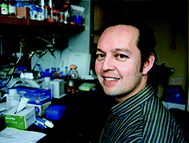Metals in Marine Biochemistry
Rachel Narehood
Austin
a and
Mak A.
Saito
b
aDepartment of Chemistry, Bates College, 5 Andrews Rd, Lewiston, ME 04240, USA. E-mail: raustin@bates.edu
bWoods Hole Oceanographic Institution, Mailstop 51, Woods Hole, MA 02543. E-mail: msaito@whoi.edu
Abstract
This editorial introduces the Metallomics themed issue Metals in Marine Biochemistry, guest edited by Rachel Austin and Mak Saito.
On a plane to Honolulu, Hawaii, in late February—having just left behind a fierce New England winter and anticipating warm weather, warm oceans, and a week listening to talks on oceanography at the Ocean Sciences 2014 meeting—it is easy to get excited about a special Metallomics issue devoted to metals in marine biochemistry. But in fact we've been excited about this special issue for a long time.
We—the coauthors of this editorial—met about 15 years ago as members of the NSF-funded Center for Environmental Bioinorganic Chemistry at Princeton University. The premise of the center, and this issue, is that bioinorganic chemistry in the oceans is special, for a number of reasons. It is special because life arose in the ancient oceans and so the chemistry of the oceans and the chemistry of life are profoundly connected in ways that skilled and creative scientists are beginning to unravel. It is special because the oceans have consistent concentrations of some elements, bringing some uniformity to their biochemistry, and dramatically limited concentrations of others, bringing starkness to their biochemistry as well. Oceans are critical for all of the biogeochemical cycles we depend on. Half the Earth's primary productivity occurs in oceans. Anthropogenic activities that are acidifying and warming the oceans will impact this biochemistry. The oceans also contain fascinating extreme environments that produce seemingly bizarre biochemistry.
Enhanced cross-pollination between metals in medicine and metals in marine environments would be fruitful for both fields, and Metallomics offers a place where the fields can meet. Professor Tom O'Halloran from Northwestern University, a former Metallomics Editorial Board Member and a current Advisory Board Member, gave a talk at one of the early CEBIC meetings, drawing parallels between the environment of a cell and the ocean environment. Where once we pictured a bag full of buffer with soluble metalloenzymes catalyzing cool reactions, we now know about metal chaperones and metal uptake proteins and complex stories about metal regulation, insertion, and trafficking. Our knowledge of the flux and stocks of metals in marine biochemistry is not as advanced as our knowledge of the stocks and fluxes of metals in yeast, but it seems likely to yield every bit as rich a picture. The rapid development of proteomic, transcriptomic, and metagenomic tools promises to infuse a field that was always at the forefront of analytical chemistry with transformative insights.
Work being done by trace metal chemical oceanographers to map the distribution of metals throughout the ocean serves as a model for all scientists working in complex matrices. Take a look at the approaches and results of the GEOTRACES project (http://www.geotraces.org/). Standards, methods and intercalibration are at the heart of this international effort, the goal of which is “to identify processes and quantify fluxes that control the distributions of key trace elements and isotopes in the ocean, and to establish the sensitivity of these distributions to changing environmental conditions”. This is essential work because “many trace elements are critical for marine life and therefore influence the functioning of ocean ecosystems and the global carbon cycle”. Part of the Metallomics mission is to encourage high standards of analytical methods in the field of metallomics. Moreover, the GEOTRACES project provides an unprecedented view (in 3D) of the global distribution of metals in the oceans for the first time. Examining those “chemical maps” could inspire any scientist interested in the interaction between metals and life to consider their chemical connections and evolutionary origins.
Fundamentally new bioinorganic chemistry has been learned by studying the biochemistry of metals in the marine environment. As an example, for years people were aware that the distribution of cadmium in the ocean follows what chemical oceanographers call “a nutrient-like” distribution: very low concentrations at the surface, consistent with it being used in biology. (Most of the biology in the oceans is focused at the top of the water column where light stimulates phytoplankton growth, which then feeds heterotrophic bacteria.) However, no required role for cadmium in biology was known; its effects on living organisms were thought to be limited strictly to its toxicity. In 2005, one of us co-authored a paper reporting the first cadmium-requiring protein, a cadmium-containing carbonic anhydrase1 later shown to be expressed in low zinc conditions.2,3
Oceans have very low levels of dissolved iron, which creates a profound challenge for marine microbes that require iron for essential life processes. There are clear parallels between iron acquisition pathways of marine microbes and pathogenic microbes facing a host environment in which iron levels are down-regulated as part of an immune response.
In “Amphiphilic siderophore production by oil-associating microbes” (DOI: 10.1039/C4MT00047A), Kem, Zane, Springer, Gauglitz, and Butler report new siderophores from microbes known to oxidize hydrocarbons. Their report resonates with questions posed in “Perspective: what is known, and not known, about the connections between alkane oxidation and metal uptake in alkanotrophs in the marine environment” (DOI: 10.1039/C4MT00041B), by Austin, Kenney and Rosenzweig, who explore connections between metal concentrations and the metalloenzymes bacteria use to catalyze the transformation of alkanes.
Siderophores have been implicated in dinoflagellate toxicity, and siderophore structure can be altered significantly by exposure to light, with profound implications for iron availability to different organisms. These issues are examined in “Evaluation of photo-reactive siderophore producing bacteria before, during, and after a bloom of the dinoflagellate Lingulodinium polyedrum” (DOI: 10.1039/C4MT00053F) by Yarimizu, Polido, Gärdes, Carter, Hilbern and Carrano.
Macromolecules made by organisms move through the environment in impactful ways. Their chemistries both in and outside organisms can affect global biogeochemical cycles, a topic discussed by Hogle, Barbeau, and Gledhill in “Heme in the marine environment: From cells to the iron cycle” (DOI: 10.1039/C4MT00031E).
Conversely, the metal complexes that form naturally in particular environments can control the biology that flourishes there. They can also serve as sentinels, reporting on the overall chemistry (e.g. pH, pO2) of the places they exist. “Stabilities of thiomolybdate complexes of iron; implications for retention of essential trace elements (Fe, Cu, Mo) in sulfidic waters” (DOI: 10.1039/C3MT00217A) by Helz, Erickson, and Vorlicek examines the chemistry of iron complexes that form under sulfur-rich, oxygen-poor conditions.
Metal ions play essential roles in all biogeochemical cycles. The nitrogen cycle is a very important nutrient cycle in marine environments, as nitrogen is often the limiting nutrient for growth. Nitrogen fixation is a metal-intense process, and much work has centered on figuring out how metals are distributed and utilized in nitrogen-fixing organisms. An important contribution to this field is made by Nuester, Newville, and Twining in “Distributions of iron, phosphorous and sulfur along trichomes of the cyanobacteria Trichodesmium” (DOI: 10.1039/C4MT00042K).
Finally, as mentioned earlier, marine environments can be sources of unusual molecules. Their importance in providing human drugs is well known. Less well exploited is their potential as a source of new bioinorganic complexes. In “The structure of ferricytochrome c522 from the psychrophilic marine bacterium Colwellia psychrerythraea 34H” (DOI: 10.1039/C4MT00045E), Harvilla, Wolcott, and Magyar present the structure of a new ferricytochrome from a cold-loving marine bacterium.
We invite members of the biochemical oceanography community to consider Metallomics a welcoming place for their work, and we anticipate that regular readers of Metallomics who might not be familiar with the questions of marine bioinorganic chemistry will be stimulated by the articles they read in this special issue and in other issues of Metallomics.
References
- T. W. Lane, M. A. Saito, G. N. George, R. C. Prince and F. M. M. Morel, Nature, 2005, 5, 42 CrossRef PubMed.
- Y. Lu, L. Feng, P. D. Jeffreys, Y. Shi and F. M. M. Morel, Nature, 2008, 452, 56 CrossRef PubMed.
- P. J. McGinn and F. M. M. Morel, Physiol. Plant., 2008, 133, 78 CrossRef CAS PubMed.
| This journal is © The Royal Society of Chemistry 2014 |


